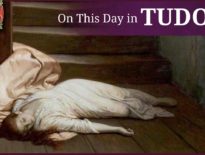On this day in history, 23rd September 1605, in the reign of King James I, Tudor pamphleteer William Averell was buried at St Peter upon Cornhill.
Averell's first work was about two Welsh star-crossed lovers, Charles and Julia, and he also wrote a Protestant work about it raining wheat in Suffolk and Essex, an event which he saw as presaging the end of the world.
Averell was an interesting character and you can find out more about him and his work in today's talk.
Also on this day in Tudor history, 23rd September 1571, 49-year-old John Jewel, Bishop of Salisbury, died after being taken ill while preaching a sermon. Not many people have heard of John Jewel, but he had an interesting life which spanned the reigns of King Henry VIII, Edward VI, Lady Jane Grey, Mary I and Elizabeth I – a time of religious change. He was a clergyman, a Protestant exile, a theologian and bishop, and someone who spoke up for what he believed. You can find out more about him in last year’s video:
Also on this day in history:
- 1568 – Battle of San Juan de Ulúa, near present day Veracruz, Mexico, between Spanish forces and English privateers led by John Hawkins. The Spanish forces were victorious.
Transcript:
On this day in history, 23rd September 1605, in the reign of King James I, Tudor pamphleteer William Averell was buried at St Peter upon Cornhill.
I’d never heard of him before I came across him when researching dates for my book “On This Day in Tudor History”, but I loved the titles of his works, which included the 1581 romantic “An excellent historie, both pithy and pleasant, on the life and death of Charles and Julia, two Brittish, or rather Welsh lovers”, the 1583 Protestant “A wonderfull and straunge newes, which happened in the county of Suffolke, and Essex, the first of February, being Friday, where in rayned wheat, the space of vi or vii miles compass”, the 1584 collection of moral narratives “A Dyall for Dainty Darlings” and the 1588 “A Mervalious Combat of Contrarieties”.
Before I tell you about a couple of his works, let me tell you about William Averell…
• Averell was baptised on 12th February 1556, in the reign of Queen Mary I, in the parish of St Peter upon Cornhill, London, and was the son of joiner John Averell and his wife Margaret or Margareta.
• Nothing is known of his early life, but Averell became a member of the Worshipful Company of Merchant Taylors and the Worshipful Company of Vintners, and worked as a parish clerk and schoolmaster in the parish of his birth.
• He married Gillian Goodale, a baker’s daughter, in November 1578. Gillian was pregnant at the time of the wedding as she gave birth to their daughter, Anne, in February 1579. The couple went on to have another 16 children, but Gillian died after the birth of the last one.
• Averell remarried at some point and had a daughter, Elizabeth, who was born in November 1597.
• His first published work was his 1581 romantic work about the Welsh star-crossed lovers, Charles and Julia. Its full title was “An excellent historie bothe pithy and pleasant, discoursing on the life and death of Charles and Iulia, two Brittish, or rather Welshe louers No lesse delightfull for varietie, then tragicall in their miserie, not hurtfull to youthe, nor vnprofitable to age, but commodious to bothe”. This work was dedicated to mercer and brewer Henry Campyon, the dedication reading “To the worshipful and his most approved friend, Maister Henry Campyon: W. A. wisheth health and wealth of body, quietness and contentation of mind, in this life fulness of felicitie, and in the life eternal true tranquillity.” Rather than being based in Italy, like Romeo and Juliet, this work was set in Britain in the time of the legendary Brutus of Troy, who was known as the first king of Britain. I’ll give you a link to read this work for yourself.
• Averell’s next work was “A wonderfull and straunge newes, which happened in the county of Suffolke, and Essex, the first of February, being Friday, where in rayned wheat, the space of vi or vii miles compass, a notable example to put us in remembrance of the judgments of God, and a preparative sent to move us to a speedy repentance”. Averell didn’t see the shower himself, but cited accounts from witnesses who saw the grain fall “in a drizzling snow”. They described it as “a softer substance, greener colour without, whiter within, and of a mealier taste than common wheat.” Averell saw it as presaging the end of the world.
• His 1584 “A Dyall for Dainty Darlings” was a collection of three moral narratives dedicated dedicated to William Wrathe, warden of the Mercers' Company. They were on divine punishment for sin and the reward for virtue.
• Then, in 1588, the same year as the Spanish Armada’s attempted invasion, Averell published his work “A mervailous combat of contrarieties Malignantlie striving in the members of mans bodie, allegoricallie representing unto us the envied state of our florishing common wealth: wherin dialogue-wise by the way, are touched the extreame vices of this present time. With an earnest and vehement exhortation to all true English harts, couragiously to be readie prepared against the enemie”, which was dedicated to Sir George Bonde, Lord Mayor of London. Averell’s biographer, William E Burns, describes this work as beginning with “a dialogue between the parts of the body in which the tongue, urging a revolt of the body against the belly and back on the grounds of their greed and pride, was eventually unmasked as a traitor” and concluding with “an exhortation for loyalty to the queen”. Burns explains that it contained attacks on Jesuits and Catholics, and that it was used as a source for William Shakespeare’s parable of the revolt of the members against the belly in his play “Coriolanus”.
In 1590, it was published with the three narratives of “A Dyall for Dainty Darlings” as “Four Notable Histories”, which was dedicated to Hugh Ofly, a Marian exile and London alderman.
• His date of death is not recorded, but he was buried on 23rd September 1605.
I’ll give you links to read his history of Charles and Julia, and his marvellous combat of contrarities:
An excellent historie bothe pithy and pleasant, discoursing on the life and death of Charles and Iulia - https://quod.lib.umich.edu/e/eebo/A23370.0001.001?view=toc
A meruailous combat of contrarieties - https://quod.lib.umich.edu/e/eebo/A23383.0001.001?view=toc



Leave a Reply